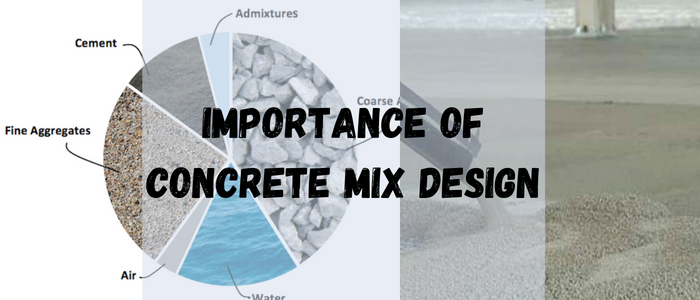Concrete Mix Design
To understand the importance of concrete mix design, let us first define what mix design is?
The concrete mix design is a process, which means there are input and outputs. Let us focus on the output now.
The outcomes from the concrete mix design process is the selection of the type and amount of concrete ingredients. Of course this can not be done randomly.
The selected materials should purpose an ultimate goal which is the production of concrete that has specific strength and durability requirements depending on the project specifications and the surrounding environmental conditions. Keep in mind also that obtained mix design has to be cost-effective from the economic point of view.
Who Design the Concrete Mix?
The quality control engineer may require a specific design. Contractors also may ask the concrete plant to procure the specific design without any limiting condition. This puts the responsibility for the mix design on the concrete production plant.
Anyways, the person to design the concrete mix must be aware of the various properties of concrete materials and how concrete performs in the fresh and hardened state. Knowledge of durability conditions is also a must.
Due to the vastly different qualities of the component materials, the site-specific conditions, particularly the exposure conditions, and the requirements for a specific job for which the mix is developed, designing concrete mixes is not an easy operation.
Importance of Concrete Mix Design
A good and sound mixture design of concrete is the basis for a reliable infrastructure and all other kinds of concrete construction.
The mixture design of concrete gives the ingredients that generate the strength and durability needed for the concrete construction. Making a perfect concrete mix is not an easy task since each component has a different set of qualities. All elements must be tested to establish their physical characteristics and make sure they are suitable for use in concrete.
- As we said, a good mixture design serve as a basis for reliable concrete.
- Concrete is exposed to environmental factors during it life. Good concrete will be capable of resisting these condition.
- The service life of a structure will only be achieved by a good design mix.
So what are the ingredients that exist in concrete?
The components for use in concrete are: cement, cement replacement materials (such as fly ash, slag and silica fume), water, sand (fine aggregate) and gravel/crushed stone (coarse aggregate), and chemical admixtures.
The values of the physical properties obtained after testing will be used as the basis for all concrete mix design considerations. This will ensure the structure will be sound and prevent failure of the mix. It is important to note that the ingredients for the mix might vary from one project location to another, so the physical properties must be tested for the requirements specified for each location.
Mix Design of Concrete has 2 Types
Concrete mixtures can be divided to two types according to the target compressive strength. These types are:
Normal Performance Concrete
The target strength of normal performance concrete (also called normal strength concrete) ranges between 20 and 40 MPa. This type of concrete is the most commonly used type since it is used in general application where no special strength requirements are needed.
Normal strength concrete is workable when all mixture components are in appropriate ratios. If you need extra workability, you can add a water-reducer.
When freshly mixed, the concrete has to keep its plasticity before molding if forms meaning that it should be plastic or semi-fluid.
High Performance Concrete
This type of concrete has a compressive strength with values above 40 MPa. High performance concrete is usually used for special applications. For example, to decrease the weight of concrete elements since it will have a smaller section, to decrease the penetrability (permeability, capillary suction, and diffusion) of concrete, to reduce creep, and extend the service life of concrete structures.
Same as normal mixtures, the concrete has to be in fluid state to be easily molded.
Due of the high cement content, high-performance concrete is usually sticky and difficult to handle and place. However, unlike with conventional strength concrete, this does not result in cement bleeding. Of course, the workability thing can be adjusted using superplasticizers.
Parameters that Affect Concrete Mix Design
The strength and durability properties of a certain concrete depend on multiple parameters related to the mix design of concrete:
Concrete Grade
Grade of concrete is the strength of concrete measured after 28 days of casting for cured concrete specimens. The grade of concrete construction is based on structural integrity and type of concrete mix.
The grade designation will depend on which code you are working according to by usually they will refer to the 28 days compressive strength.
Cement Type
There are multiple types of cement that can employed in a mixture design. Each cement type has a specific feature that makes it more suitable for a certain purpose over the other.
Aggregate Size
The physical qualities required for the design will determine the type of aggregates required for each mix. Prior to usage, all aggregates must be properly sized.
Type of water
The type of water that should be used in mixing is potable water, which is the water suitable for drinking. If you have doubts on the quality of water, do the tests necessary to verify it quality.
Water-to-Cement Ratio (abbreviated as W/C)
The w/c ratio is very very important for a mix design. It has a direct relationship to the strength of concrete, workability, setting time and durability. That is why extreme care has to be given for the selection and achievement of the w/c.
Workability
The level of workability needed for a specific job also affects the mixture design. Concrete should be workable without excessive bleeding or segregation.
Durability
Durability is the ability of a material to resist weathering action, chemical attack, abrasion, and other conditions of service.
Read Also:
